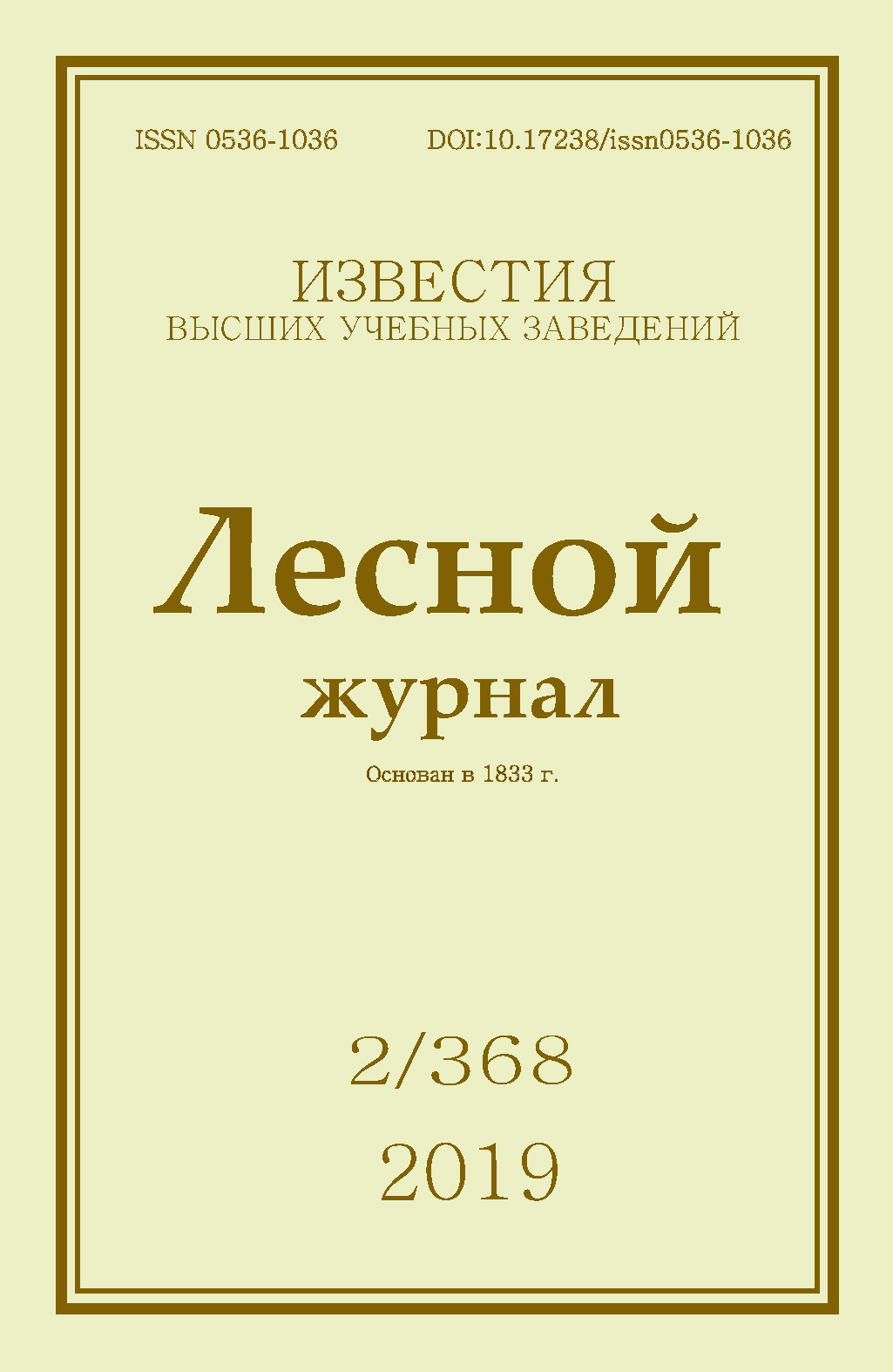Artificial Reforestation of Siberian Pine Forests in Tomsk Region
DOI:
https://doi.org/10.17238/issn0536-1036.2019.2.9Keywords:
Siberian pine (Pinus sibirica Du Tour), forest crops, southern taiga, middle taiga, Tomsk region, optimization of forest regenerationAbstract
The problem of artificial reforestation is widespread both in the world and Russia. This applies especially to the development of Siberian pine (Pinus sibirica Du Tour crops). The article summarizes the experience of artificial regeneration of Siberian pine forests in the southern and middle taiga of Tomsk region. As a research result it has been established that predominant soil preparation by furrows in the logging areas with the help of a bottom plow is inappropriate; since herewith the topsoil is removed, which causes a delay in Siberian pine growth for 8–10 years. It was revealed that the planting of Siberian pine into the furrow bottom leads to its rotting and covering up with herbaceous vegetation. In the middle taiga it is possible to plant crops without soil preparation; in many scenarios it is essential. The most appropriate aids of laying out Siberian pine crops are microhills and fire lines with pre-served topsoil. It is preferable to plant forest crops with large-sized planters, which will make it possible to refuse from agrotechnical tending in case of low grass cover. The density of crops can be small (1.2–1.5 thousand pcs/ha); and, moreover, the forest environment is preserved due to the associated species. Siberian pine crops in the logging areas are overgrown throughout with hardwood species, which delay their development for many years. High intensity improvement thinning of Siberian pine crops up to the cleanout of deciduous layer is the most important and extremely necessary forest management measure for reforestation of Siberian pine forests.
For citation: Debkov N.M., Panevin V.S. Artificial Reforestation of Siberian Pine Forests in Tomsk Region. Lesnoy Zhurnal [Forestry Journal], 2019, no. 2, pp. 9–21. DOI: 10.17238/ issn0536-1036.2019.2.9
Downloads
References
Косицын В.Н. Оценка состояния лесных культур кедра при государственной инвентаризации лесов // Лесная таксация и лесоустройство. 2014. № 1(51). С. 65–68.
Красильников П.К. Методика полевого изучения подземных частей растений: моногр. Л.: Наука, 1983. 207 с.
Лоскутов Р.И. Искусственное восстановление кедра сибирского: моногр. М.: Лесн. пром-сть, 1971. 105 с.
Медведева А.А. Особенности искусственного лесовосстановления на Причулымском плато: дис. … канд. с.-х. наук. Л., 1975. 180 с.
Новосельцева А.И. За дальнейшее развитие лесовосстановительных работ в многолесных районах европейской части СССР // Лесн. хоз-во. 1972. № 2. С. 15–17.
Об утверждении Перечня лесорастительных зон Российской Федерации и Перечня лесных районов Российской Федерации: приказ М-ва природ. ресурсов и экологии Российской Федерации от 18.08.2014 № 367. Режим доступа: http://docs.cntd.ru/ document/420224339 (дата обращения: 11.11.2018).
Огиевский В.В. Искусственное лесоразведение в Сибири. М.: Гослесбумиздат, 1962. 176 с.
Огиевский В.В., Хиров А.А. Обследование и исследование лесных культур. Л.: Изд-во ЛТА, 1967. 52 с.
Терехов Г.Г., Усольцев В.А., Луганский Н.А., Колтунова А.И. Состояние и рост культур кедра сибирского в подзоне южной тайги Среднего Урала // Изв. Оренбург. гос. аграр. ун-та. 2015. № 2(52). С. 13–16.
Федорович Э.С. Воспроизводство лесов в южнотаежной зоне Новосибирской области // Проблемы лесовосстановления в таежной зоне СССР: тез. докл. Всесоюз. конф., Красноярск, 13–15 сент. 1988 г. Красноярск: Ин-т леса и древесины им. В.Н. Сукачева, 1988. С. 234–235.
Aleksandrowicz-Trzcińska M., Drozdowski S., Wołczyk Z., Bielak K., Żybura H. Effects of Reforestation and Site Preparation Methods on Early Growth and Survival of Scots Pine (Pinus sylvestris L.) in South-Eastern Poland // Forests. 2017. Vol. 8, iss. 11. Pp. 1–17. DOI: 10.3390/f8110421
Dzerina B., Girdziusas S., Lazdina D., Lazdins A., Jansons J., Neimane U., Jansons Ā. Influence of Spot Mounding on Height Growth and Tending of Norway Spruce: Case Study in Latvia // Forestry Studies. 2016. Vol. 65. Pp. 24–33. DOI: 10.1515/fsmu-2016-0009
Gelderman M.S., Macdonald S.E., Gould A.J. Regeneration Niche of Whitebark Pine in the Canadian Rocky Mountains: The Basis to Restoring an Endangered Species // Arctic, Antarctic, and Alpine Research. 2016. Vol. 48, no. 2. Pp. 279–292. DOI: 10.1657/AAAR0015-057
Guldin J.M. Silvicultural Options in Forests of the Southern United States under Changing Climatic Conditions // New Forests. 2019. Vol. 50, iss. 1. Pp. 71–87. DOI: 10.1007/s11056-018-9656-2
Mallik A., Kravchenko D. Black Spruce (Picea mariana) Restoration in Kalmia Heath by Scarification and Microsite Mulching // Forest Ecology and Management. 2016. Vol. 362. Pp. 10–19. DOI: 10.1016/j.foreco.2015.10.020
Mc Carthy R., Rytter L., Hjelm K. Effects of Soil Preparation Methods and Plant Types on the Establishment of Poplars on Forest Land // Annals of Forest Science. 2017. Vol. 74, iss. 2. Pp. 1–12. DOI: 10.1007/s13595-017-0647-9
Prévost M., Dumais D. Long-Term Growth Response of Black Spruce Advance Regeneration (Layers), Natural Seedlings and Planted Seedlings to Scarification: 25th Year Update // Scandinavian Journal of Forest Research. 2018. Vol. 33, iss. 6. Pp. 583–593. DOI: 10.1080/02827581.2018.1430250
Sewerniak P., Stelter P., Bednarek R. Effect of Site Preparation Method on Dynamics of Soil Water Conditions on Inland Dunes of the Toruń Basin // Sylwan. 2017. Vol. 161(1). Pp. 52–61.
Thiffault N. Short-Term Effects of Organic Matter Scalping on the Growth and Nutrition of Black Spruce and Jack Pine Seedlings Planted in the Boreal Forest // The Forestry Chronicle. 2016. Vol. 92, no. 2. Pp. 221–231. DOI: 10.5558/tfc2016-041
Thiffault N., Hébert F. Mechanical Site Preparation and Nurse Plant Facilitation for the Restoration of Subarctic Forest Ecosystems // Canadian Journal of Forest Research. 2017. Vol. 47(7). Pp. 926–934. DOI: 10.1139/cjfr-2016-0448







